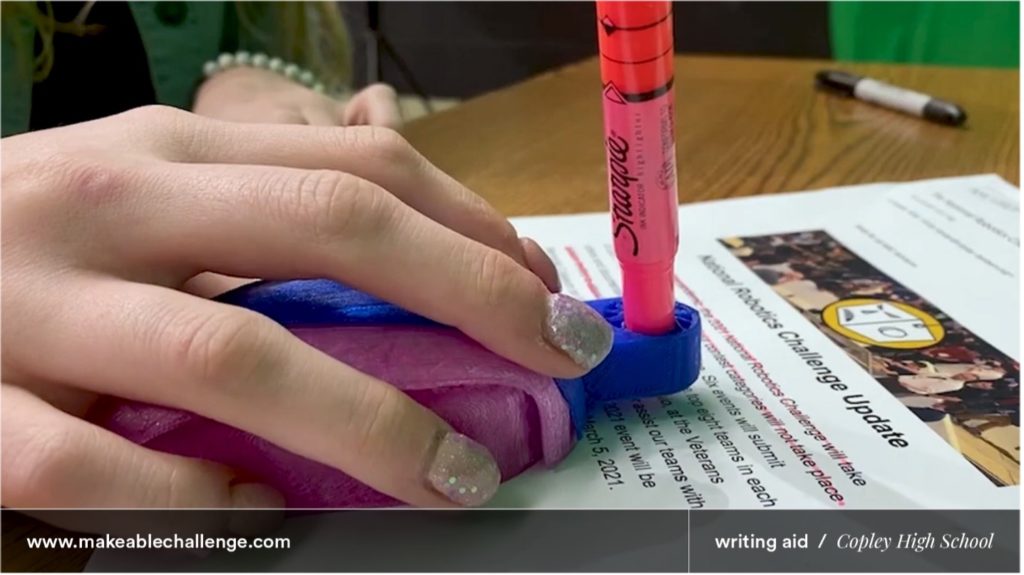
National STEM Day is just around the corner, offering the perfect opportunity to reflect on the ways STEM education prepares students, imparting the skills they’ll need to imagine and create a better world. Technological advancements are accelerating change across industries and a STEM-focused curriculum supports students to get ahead of these shifts, not just keep pace with them. Investing in STEM-based education is so important to Autodesk that we have teamed up with PrintLab—an online platform for 3D lesson plans and projects—to develop an annual design challenge that will help prepare students for future careers.
The rules for last school year’s make:able challenge were simple: to make a product or prototype with accessible design that improves the day-to-day life of someone who struggles with mobility in their hands using either Autodesk Tinkercad or Autodesk Fusion 360. Participants in the challenge explored what it means for objects to be designed by, with, and for people with disabilities. They are also learning how to solve problems, integrate new 3D printing technologies, and manufacture products through a design-thinking process. Students in the challenge utilize empathetic design at the center of their work, applying their creativity to helping actual humans with their daily struggles.
“Having supported hundreds of schools with 3D printing curricula, we have witnessed firsthand some amazing student talent across the globe,” says PrintLab co-founder Jason Yeung. “It is our belief that this talent should expand outside of the classroom and be put to use on real-world challenges that have a positive impact on society. Make:able offers a complete framework for schools to achieve this and we’re very excited to showcase how students can be at the forefront of digital and additive manufacturing.”
The Winner of the make:able Design Challenge
Over 150 teams around the globe participated in this accessibility design challenge using Autodesk software. Teachers could access a wide library of lesson plans to support their students’ journies, along with tutorials and other resources that served as inspiration for the students themselves.
The results? Students designed a wide range of innovative products, such as wheelchair accessories, writing aids, bottle and jar openers, adapted scissors, pill dispensers, instrument holders, eating devices, hand sanitizer assistants, seat belt assists, grips for household products (such as hairdryers and toothbrushes), and grabbing devices. Students brought their ideas to life while simultaneously learning industry-relevant design and engineering skills to help promote accessibility in design.

Steven Parkinson, who collaborated on behalf of Autodesk to develop this accessible design challenge with PrintLab, did so to equip students with design and engineering skills and to create a platform for students to express their creativity. “Students have produced an array of innovative ideas that genuinely contribute toward making a better world,” says Parkinson. “The make:able challenge has allowed students to learn new tools, develop their existing design and making skills, and apply all of this within a human-centered mindset.”
Design for Accessibility
Autodesk Tinkercad, a free, web-based software, is basically a starting point for students interested in design and engineering. It was designed to equip the next generation of designers and engineers develop the foundational skills needed to innovate in 3D design, electronics, and coding. As students take the next step in their 3D education, they can graduate seamlessly to professional-grade tools like Autodesk Fusion 360 to add complexity to their ideas and bring them to life. And this is exactly what students did in this year’s make:able challenge.
Starting by simply dragging and dropping shapes, students quickly took their ideas from concept to design and, through iteration, developed them into final products that could be shared and fabricated in multiple ways.
Designing in Tinkercad invites all types of learners into the design process and allows educators to proactively plan for variability of learners in their classrooms through its engaging and user-friendly platform.

If you find yourself looking for new ways to weave empathetic design into your curriculum, the 2021 make:able challenge is just around the corner. Students can design for accessibility and make a product or prototype that improves the day-to-day life of someone with a disability or an elderly person, all the while gaining valuable design expertise.
Gaining skills for a future career while doing good enabling accessibility in design — what’s not to love about that?